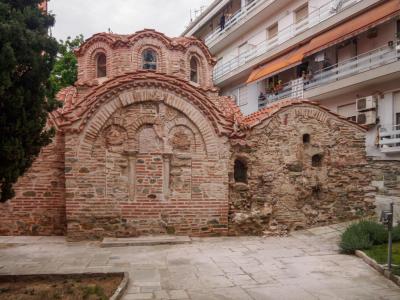Byzantine Bath, Thessaloniki
The Byzantine Bath of Thessaloniki stands as the lone survivor among the city's ancient bathhouses and ranks among Greece's most well-preserved relics from antiquity. Constructed in the late 12th or early 13th century, it remained operational until 1940, when it ceased operations, likely due to the upheavals of World War II and the German occupation of Greece. Originally believed to be part of a monastery complex, during Ottoman rule it came to be known as Kule Hammam, or the "Bath of the Citadel".
Reflecting Roman architectural conventions, the bathhouse features an entrance to the south leading to the frigidarium, or dressing rooms, followed by two tepidarium, or warm rooms, distinguished by their vaulted ceilings, and two caldarium, or hot rooms, both equipped with hypocaust heating systems. Adjacent to the bathhouse to the north was a cistern heated by a hearth beneath it, ensuring a supply of hot water.
Throughout its extensive history of use, the original structure underwent numerous modifications. While in the Byzantine era, it was utilized by both men and women interchangeably, under Ottoman rule, it was partitioned into segregated sections for each gender by blocking off pairs of rooms.
After its closure in 1940, the bathhouse suffered neglect and damage during the earthquakes of 1978, surviving largely due to the efforts of the 9th Ephorate of Byzantine Antiquities and protection provided by an external metal sheet. Recognizing its significance, UNESCO added the Bath of Thessaloniki to its list of World Heritage Sites in 1988, alongside other Paleochristian and Byzantine monuments in the city.
Following extensive restoration efforts spanning four years, the bathhouse was reopened to the public in June 2015, serving as both a museum and cultural venue.
Reflecting Roman architectural conventions, the bathhouse features an entrance to the south leading to the frigidarium, or dressing rooms, followed by two tepidarium, or warm rooms, distinguished by their vaulted ceilings, and two caldarium, or hot rooms, both equipped with hypocaust heating systems. Adjacent to the bathhouse to the north was a cistern heated by a hearth beneath it, ensuring a supply of hot water.
Throughout its extensive history of use, the original structure underwent numerous modifications. While in the Byzantine era, it was utilized by both men and women interchangeably, under Ottoman rule, it was partitioned into segregated sections for each gender by blocking off pairs of rooms.
After its closure in 1940, the bathhouse suffered neglect and damage during the earthquakes of 1978, surviving largely due to the efforts of the 9th Ephorate of Byzantine Antiquities and protection provided by an external metal sheet. Recognizing its significance, UNESCO added the Bath of Thessaloniki to its list of World Heritage Sites in 1988, alongside other Paleochristian and Byzantine monuments in the city.
Following extensive restoration efforts spanning four years, the bathhouse was reopened to the public in June 2015, serving as both a museum and cultural venue.
Want to visit this sight? Check out these Self-Guided Walking Tours in Thessaloniki. Alternatively, you can download the mobile app "GPSmyCity: Walks in 1K+ Cities" from Apple App Store or Google Play Store. The app turns your mobile device to a personal tour guide and it works offline, so no data plan is needed when traveling abroad.
Byzantine Bath on Map
Sight Name: Byzantine Bath
Sight Location: Thessaloniki, Greece (See walking tours in Thessaloniki)
Sight Type: Attraction/Landmark
Guide(s) Containing This Sight:
Sight Location: Thessaloniki, Greece (See walking tours in Thessaloniki)
Sight Type: Attraction/Landmark
Guide(s) Containing This Sight:
Walking Tours in Thessaloniki, Greece
Create Your Own Walk in Thessaloniki
Creating your own self-guided walk in Thessaloniki is easy and fun. Choose the city attractions that you want to see and a walk route map will be created just for you. You can even set your hotel as the start point of the walk.
Thessaloniki Waterfront Tour
The Mediterranean has always been an integral part of Thessaloniki’s appeal. The city's orientation toward the sea is largely due to the vision of Ernest Hébrard, the French urban planner and architect, who redesigned the downtown area after the devastating fire of 1917.
To really get the taste of Thessaloniki you need to visit not just its historical landmarks, but also those spots... view more
Tour Duration: 1 Hour(s)
Travel Distance: 2.6 Km or 1.6 Miles
To really get the taste of Thessaloniki you need to visit not just its historical landmarks, but also those spots... view more
Tour Duration: 1 Hour(s)
Travel Distance: 2.6 Km or 1.6 Miles
Thessaloniki Upper Town Walking Tour
Thessaloniki's Upper Town (Ano Poli) is the most ancient part of the city, aged approximately 2,300 years. Being also the highest part of Thessaloniki, dominated by the Acropolis with the Byzantine-/Ottoman-era fort known as Heptapyrgion (Eptapyrgio), from here on a clear day you can see way across the gulf, as far as Mount Olympus, some 80 km (50 miles) away, towering over the horizon in all... view more
Tour Duration: 2 Hour(s)
Travel Distance: 4.0 Km or 2.5 Miles
Tour Duration: 2 Hour(s)
Travel Distance: 4.0 Km or 2.5 Miles
Thessaloniki Introduction Walking Tour
Thessaloniki is Greece's second-largest city as well as its second major political, industrial, commercial, and economic center.
Historically, Thessaloniki co-ruled the Byzantine Empire along with Constantinople. But its history goes back even further than that. Cassander of Macedon originally founded the city in 315 BC. Cassander named the city after his wife, Thessalonike. Thessalonike... view more
Tour Duration: 2 Hour(s)
Travel Distance: 3.7 Km or 2.3 Miles
Historically, Thessaloniki co-ruled the Byzantine Empire along with Constantinople. But its history goes back even further than that. Cassander of Macedon originally founded the city in 315 BC. Cassander named the city after his wife, Thessalonike. Thessalonike... view more
Tour Duration: 2 Hour(s)
Travel Distance: 3.7 Km or 2.3 Miles






